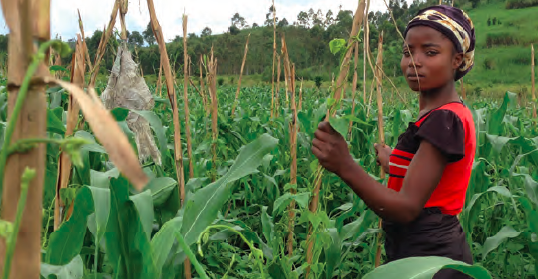The challenges faced in providing sustainable management of acute malnutrition services in Ituri Province, Democratic Republic of the Congo
 Cosma Bakemwanga Sapeke is the coordinator of the Ituri National Nutrition Programme (Pronanut by its French acronym) in Bunia, Democratic Republic of Congo. He has worked at the Ministry of Health since 2002
Cosma Bakemwanga Sapeke is the coordinator of the Ituri National Nutrition Programme (Pronanut by its French acronym) in Bunia, Democratic Republic of Congo. He has worked at the Ministry of Health since 2002
The Democratic Republic of Congo (DRC) has a population of almost 75 million, of whom two thirds live below the poverty line. The DRC is characterised by ongoing conflict, poor infrastructure and highly challenging logistics, all of which have had a severe impact on the health infrastructure and government-funded services. Conflict in the eastern provinces causes continued displacement. According to DRC’s Demographic and Health Survey 2013-14, among children under five, 43% are stunted and 8% are acutely malnourished (wasted), with ten territories having rates of acute malnutrition above the emergency threshold of 15%.
Making the benefits of a post-conflict or emergency nutritional intervention sustainable is a necessary process, but it is not always easy to implement and can sometimes lead to frustration in the performance of the programmes. Ituri Province in the east is notorious for conflict and violence and the population shifts that have taken place over the last ten years. As in most of the country, the population has very limited access to basic social services such as health, education, drinking water and electricity. The area has witnessed various changes of strategy for themanagement of acute malnutrition, alternating between a focus on treatment with excellent results but with low programme coverage and the exclusion of the community from the programme, to a focus on more integrated approaches with the health sector and the prospect of greater sustainability, but which is more problematic in terms of programme quality.
Local solutions for local problems
The Rimba health zone in Ituri Province was supported by an international NGO, but in 2008 the partner withdrew its support and the responsibility was transferred to the National Nutrition Programme (Pronanut). Integration of the management of acute malnutrition (iMAM) in the health system is now effective and functional, but the regular supply of treatment products remains a major challenge. The health zones are dependent on outside supplies and they have no control over quantities or delivery times. This often leads to stock shortages. In the face of frequent shortages of therapeutic milk, some of the therapeutic nutrition units follow the WHO recipe with dried skimmed milk to make therapeutic milk. Maximum care is given, but the protocol is not strictly adhered to, resulting in excessively high death rates in the Therapeutic Feeding Centres (Unités de Nutrition Thérapeutiques – UNT), as well as low recovery rates and a high turnover. These stock-outs impact on the quality of care as well as on the motivation of the staff.
The health authorities in Ituri have decided to also focus on preventative activities and to do so by integrating nutrition into other sectors. This includes promoting the early initiation of and exclusive breastfeeding, adequate complimentary feeding, strategies to address vitamin A, iron and iodine deficiency, deworming and the consumption of a varied diet.
In order to foster preventative approaches to addressing malnutrition, it has been necessary to involve other partners to cover all the health areas.
The leadership of local authorities, in the framework of the Local Nutrition Committee (Comité Locale de Nutrition – CLN), has also been instrumental to ensure this coverage. For example, designated land is used for farming demonstrations by extension workers, promoting the planting of diversifiedcrops rich in nutrients (beans, peanuts, sweet potato, tomato and aubergines) for local consumption by households with malnourished children and they have set up women’s farming groups and provided education on healthy eating.
In the Rimba health zone, an appeal to the FAO has enabledseeds and tools for tilling to be distributed in 18 health areas. Members of the CLN have thus been able to promote locally produced food thanks to the support of women’s agricultural associations in the region.
Community participation and capacity-strengthening have enabled the communities to participate in identifying problems and tracking cases of malnutrition. Nutritional screening at community level still exists, even if it is not as intensive as when NGOs supported these activities through a financial incentive. The involvement of the people concerned is vital to ensure the sustainability of these activities.
Conclusions
It is essential that good-practice examples, such as that of Rimba health zone’s new approach focusing on preventative measures, be taken up by others if malnutrition is to be prevented. It needs to be recognised as being part of a multisector approach and the responsibility of all concerned.
The experience of Ituri has shown that the best method of combatting malnutrition is integration of nutrition activities into the existing health system – ensuring sufficient financial resources and systems to provide an adequate supply chain for nutrition products where treatment is needed – and the development of mechanisms to prevent new cases of malnutrition through raising awareness and increased production and consumption of locally produced, micronutrient-rich foodstuffs.
Previous high levels of international actor investment to address acute malnutrition cannot be maintained once the nutrition partner and the funding goes; however it is hoped that with time, the previous implementation experience can be adapted in line with will local capacity and resources.
